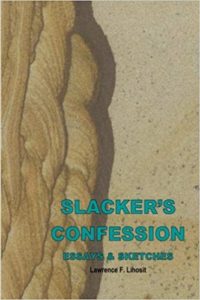Review — SLACKER’S CONFESSION by Lawrence Lihosit (Honduras)
Slacker’s Confession: Essays and Sketches
By Lawrence F. Lihosit (Honduras 1975-77)
CreateSpace
184 pages
January 2018
$18.95 (paperback)
Reviewed by Darcy Meijer (Gabon 1982-84)
•
Lawrence F. Lihosit’s latest book is a simple delight. His dozens of sketches make drawing look easy, and the essays are conversational and candid. His work and travels have taken him to Central and South America, and after eight years he carried home sketchbooks filled with 150 drawings and essays on art, travel, inspiration and technique.
Slacker’s Confession is a tidy book in terms of scope and sequence: four parts, each with essay and sketches. Part I comprises Lihosit’s title essay and sketches from Uruguay, Argentina and Chile; part II his essay “Pen to Paper” and sketches from Bolivia, Peru and Ecuador; part III “Drawing Outdoors” and sketches from Panama, Honduras, El Salvador and Guatemala; Part IV “Materials” and sketches from Caribbean and South and Central Mexico.
Lihosit is a retired urban planner and discusses his sketches in terms of the tools and media he uses as well as environmental elements. He sketches in pen and ink, water-based and alcohol-based marker, and ball point pen. I have dog-eared more than twenty sketches, admiring them again and again for their simplicity of line, mastery of light and shadow, and fine depiction of structures and humans. “That’s Machu Pichu! Look at the shadowing.” “Compay Hostel in Uruguay – I’d love to be there.” “Calle 9 & Av. Central in Panama City – I’ve seen corners just like that in Europe.” My favorite sketch – hard to choose – is “Campeche, Mexico – Old Town.” Just the way the guy sits on his motorcycle gets me.
Slacker’s Confession reviews the difference between writing and drawing. Writing is intellectual; it is exhausting whereas sketching involves “manual dexterity and the ability to concentrate on the visual.” It refreshes Lihosit and time flies. He reviews the pros and cons of using a camera to sketch and describes how his urban planning skills come into play in his art.
For me, the book is an argument to take out my watercolors and dusty sketchbooks again. Not only is sketching a recreation and exercise: it’s a way of recording. My family and I will be working in the Republic of Congo (Brazzaville) next fall, and I plan to sketch and write my impressions like the “Slacker.”
Of travelling, Lihosit claims, “Travel sweats fat off the brain and in so doing, becomes an epiphany for discovering one’s own strengths and weaknesses.” Indeed, living overseas teaches us about ourselves, shaves off layers larded on the brain by familiar and complacent living, and sharpens the senses. In a complementary way, drawing is a way to appreciate and hold in the mind new experiences.
Lihosit’s highly-rated 12 books include Jesus Was Arrested in Mexico City and Missed the Wedding; South of the Frontera: A Peace Corps Memoir; and Travels in South America. I highly recommend Slacker’s Confession for its thoughtful essays and masterful sketches.
•
Darcy Meijer was a Peace Corps TEFL Volunteer in Gabon from 1982-1984. She currently teaches ESL at Auburn University in Alabama.

We loved this book! My husband had been a student in Mexico City back in the 60s and recognize some favorite places from
Lihosit’s sketches. The one I keep returning to is on page 27: Montevideo, Urugauy, Tinglado Theater. It is of man, sitting. For me, in so many ways, it is evocative of South America.
The only puzzle for me is the title: Slacker’s Confession. Lawrence (Lorenzo) Lihosit is prolific, constantly writing, commenting, observing. teaching. What’s with this “Slacker” nonsense!
Thank you, Darcy, for taking the time to read and comment on my artsy-fartsy book. This old coot had a great time putting it together. Also, thank you John, for permitting a review of a very different type of travel book.